.
27.01.2016
COMETWATCH 17 JANUARY
Today's CometWatch features a NAVCAM image taken on 17 January 2016, when Rosetta was 83.4 km from the comet nucleus. The scale is 7.1 m/pixel and the image measures 7.3 km across.
.
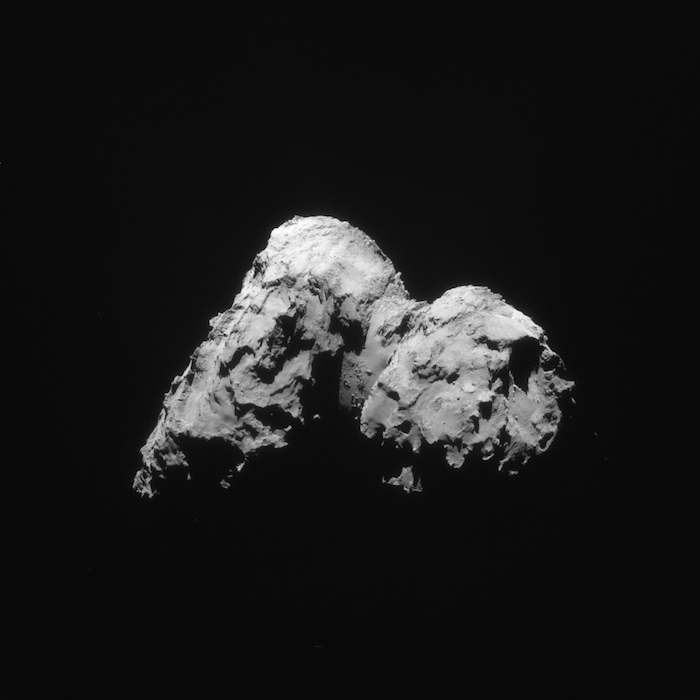
Enhanced NAVCAM image of Comet 67P/C-G taken on 17 January 2016, 83.4 km from the nucleus. Credits: ESA/Rosetta/NAVCAM – CC BY-SA IGO 3.0
The image shows 67P/C-G with the large lobe on the left and the small one on the right, in a similar orientation to that of CometWatch 16 August 2015. In that image, taken only three days after perihelion, the comet's spectacular activity dominated the view, while today's image reveals more of the diversity of terrains that are found on the surface.
In the upper part, we see a rough portion of the Khepry region (on the left) and a seemingly smoother portion of Aker (on the right). These two areas were often portrayed in CometWatch entries from April and May 2015, for example in this image from 21 May.
Towards the left edge of the nucleus, this view reveals the narrow and elongated Aten. At the centre of the large lobe is the Babi region, bridging to the dust covered terrains of Ash on the lower left and to Seth, which is almost entirely cast in shadow, on the lower right.
This image also beautifully portrays the string of boulders on the smooth Hapi region, on the 'neck' of the comet, leading towards the more rugged Sobek towards the top right.
On the small lobe, we see the rough Bastet region (top) neighbouring smoother portions of Ma'at (bottom). To the right, the large circular depression of Hatmehit is depicted in a striking contrast of bright and shadowed areas that reveal many boulders lying in this region.
You can use the interactive comet viewer tool to explore the various regions of the surface of 67P/C-G.
The original 1024 x 1024 image is provided below.
.
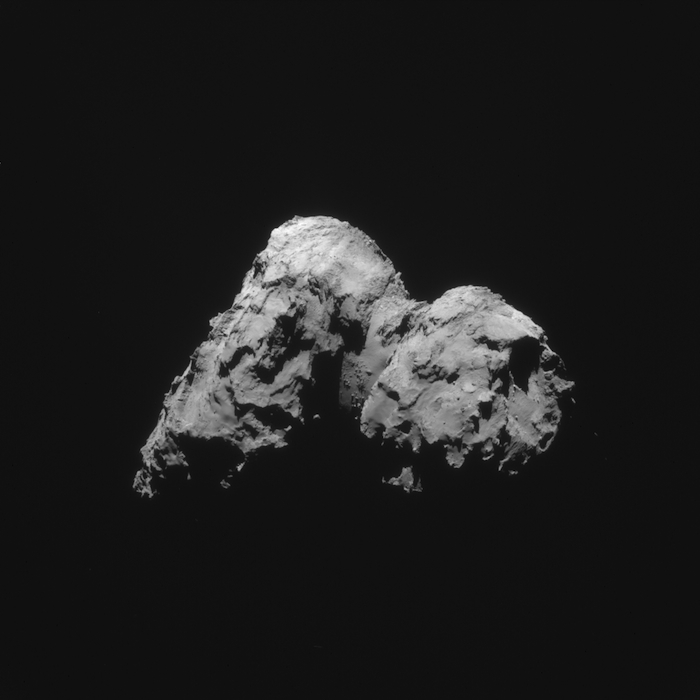
---
TWIN TAILS
Amateur and professional astronomers alike have been monitoring changes in Comet 67P/Churyumov-Gerasimenko’s tail, which, since December, has been exhibiting two prominent structures.
.

Image of 67P/C-G obtained with the 2.5m Isaac Newton Telescope on La Palma on the morning of 19 January 2016. The picture was taken through a red filter; the apparent colour has been added to help pick out faint structures by eye. The tail extends 0.5 degrees from the nucleus (the apparent size of the full moon) before reaching the edge of the image, corresponding to a minimum length of 2.2 million km. Note that the thick black lines are gaps between CCDs in the array (the camera has 4 CCDs to cover half a degree). Credit: Alan Fitzsimmons / Isaac Newton Telescope.
“Current indications from the data we’re collecting of Comet 67P/C-G is that both features are dust structures,” says professional astronomer Alan Fitzsimmons, who has recently spent time observing the comet with the Isaac Newton Telescope in La Palma.
Multiple tail structures are not uncommon in comets, and indeed have been observed during previous apparitions of Comet 67P/C-G.
The two portions of the tail are attributed to different populations of dust grains swept away from the comet’s nucleus by the radiation pressure of the Sun over the course of its 6.5 year orbit around the Sun.
In the image above, taken with the 2.5m Isaac Newton Telescope on La Palma, the upper ‘streamer’ is precisely aligned along the projected orbit of the comet, implying it is made of large and/or old dust grains moving slowly along the orbit of comet. This part is called a comet dust trail because it is formed from the particles trailing along the path of a comet. This dust trail of Comet 67P/C-G has been seen several times before by both ground-based telescopes and space-based infrared observatories.
The lower portion of the dust tail exhibits a thin central core and resembles a feature called a neckline structure. This is formed from dust grains released on the “opposite side” of the orbit from the time of the observation, and all lining up as seen from Earth. This has also been seen before in previous returns of Comet 67P/C-G.
“We need to do more calculations and modelling, but if our interpretation is correct, then the dust grains forming the neckline in December 2015 were ejected from the comet nucleus around March last year, prior to perihelion,” says Alan.
The dust coma can also be seen all around the comet nucleus, with a peak extending just ahead of the comet, and with a broader tail of smaller dust grains swept out below the neckline.
.
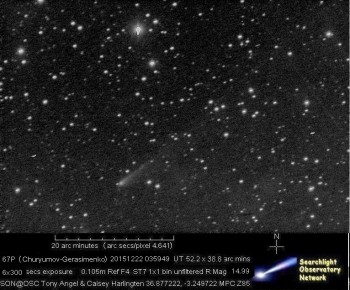
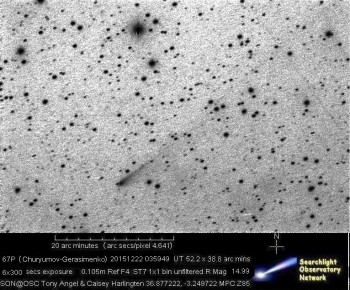
The amateur community is also acquiring regular images of the comet.
“Because the large telescopes have nowhere near the time-coverage that the amateur/pro-am community have, it’s fantastic to see the amount of valuable data people are collecting,” adds Alan.
For example, the images shown left were taken by Tony Angel and Caisey Harlingten through a 4” telescope of the Searchlight Observatory Network at the Observatorio Sierra Contraviesa, Spain, on 22 December 2015. The image was made by stacking six images taken with an exposure of 300 seconds each in order to bring out deep details of the faint, extended tail structures.
The image is shown in positive (top) and negative (bottom).
Credits: SON@OSC/T. Angel & C. Harlingten.
Astronomer Damian Peach has also been keeping a regular eye on the comet as it moves across the sky. The colour composite below captures the comet between September and November last year, showing the comet’s tail and its fuzzy coma. (Click here for an image taken more recently by Damian, on 18 January.)
.
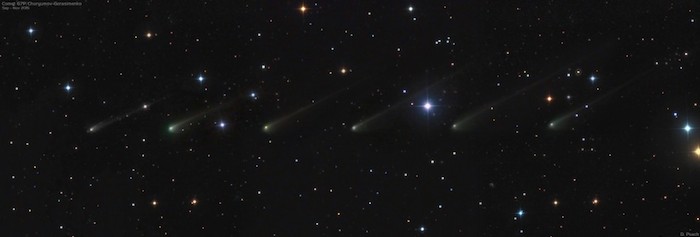
Comet 67P/C-G between September and November 2015 seen in six LRGB images acquired with a 24" CDK telescope with FLI camera by Damian Peach. Each section is composed of 8 x 120 second exposure images. During this time, the tail is estimated to measure around 20–30 arc mins. Credit: D. Peach.
“Collecting data from Earth while Rosetta is flying alongside the comet is providing a unique and complementary dataset that will help both Rosetta mission scientists and ground-based astronomers understand processes relating to the comet’s activity at a range of scales,” says Rosetta project scientist Matt Taylor. “We’re hoping that ground based images will continue to be obtained until later this summer when the comet gets fainter and too close to the Sun in the sky to observe.”
Quelle: ESA
.
Update: 4.01.2016
.
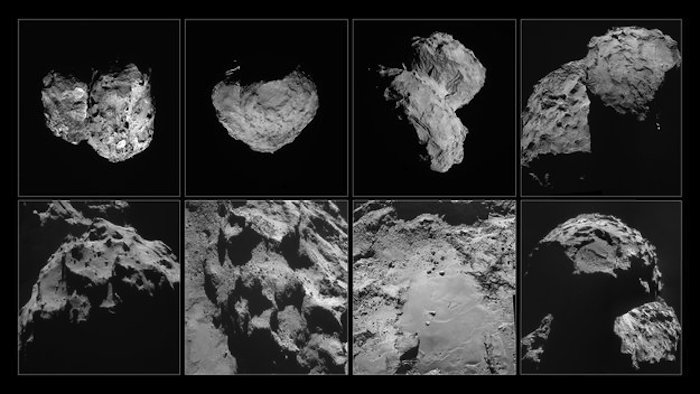
Comet 67P/Churyumov-Gerasimenko
INSIDE ROSETTA’S COMET
-
There are no large caverns inside Comet 67P/Churyumov-Gerasimenko. ESA’s Rosetta mission has made measurements that clearly demonstrate this, solving a long-standing mystery.
Comets are the icy remnants left over from the formation of the planets 4.6 billion years ago. A total of eight comets have now been visited by spacecraft and, thanks to these missions, we have built up a picture of the basic properties of these cosmic time capsules. While some questions have been answered, others have been raised.
Comets are known to be a mixture of dust and ice, and if fully compact, they would be heavier than water. However, previous measurements have shown that some of them have extremely low densities, much lower than that of water ice. The low density implies that comets must be highly porous.
But is the porosity because of huge empty caves in the comet’s interior or it is a more homogeneous low-density structure?
In a new study, published in this week’s issue of the journal Nature, a team led by Martin Pätzold, from Rheinische Institut für Umweltforschung an der Universität zu Köln, Germany, have shown that Comet 67P/Churyumov-Gerasimenko is also a low-density object, but they have also been able to rule out a cavernous interior.
This result is consistent with earlier results from Rosetta’s CONSERT radar experiment showing that the double-lobed comet’s ‘head’ is fairly homogenous on spatial scales of a few tens of metres.
The most reasonable explanation then is that the comet’s porosity must be an intrinsic property of dust particles mixed with the ice that make up the interior. In fact, earlier spacecraft measurements had shown that comet dust is typically not a compacted solid, but rather a ‘fluffy’ aggregate, giving the dust particles high porosity and low density, and Rosetta’s COSIMA and GIADA instruments have shown that the same kinds of dust grains are also found at 67P/Churyumov-Gerasimenko.
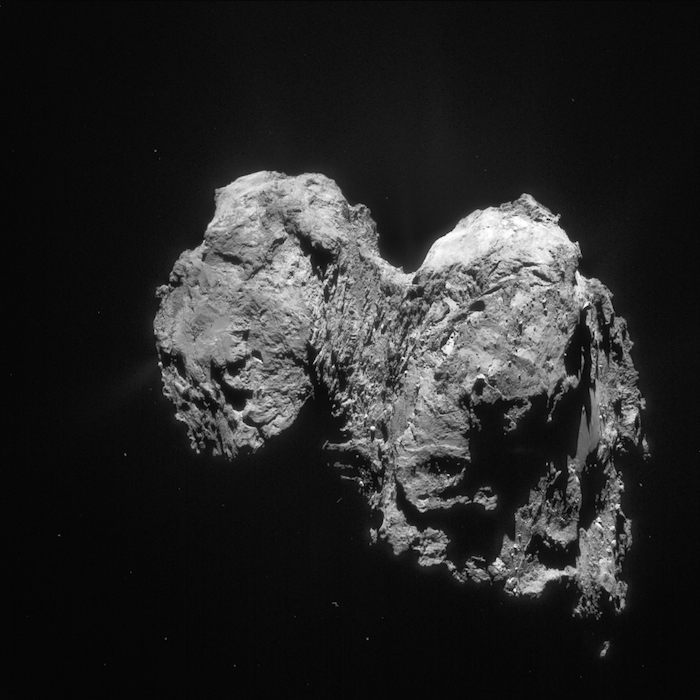
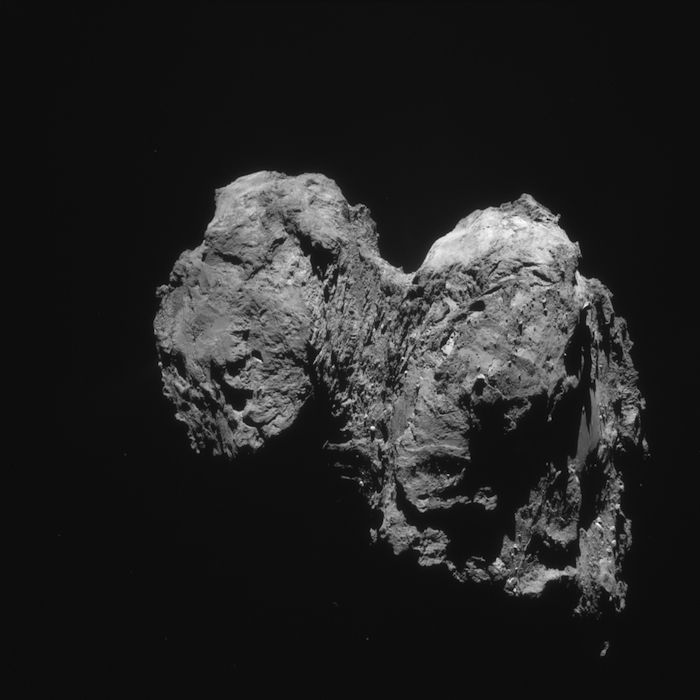
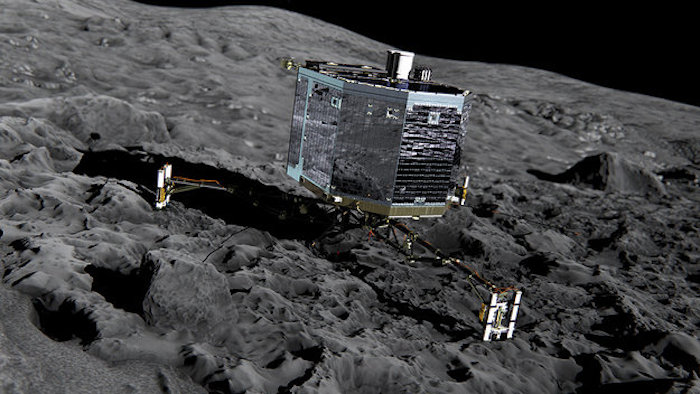
Pätzold’s team made their discovery by using the Radio Science Experiment (RSI) to study the way the Rosetta orbiter is pulled by the gravity of the comet, which is generated by its mass.
The effect of the gravity on the movement of Rosetta is measured by changes in the frequency of the spacecraft’s signals when they are received at Earth. It is a manifestation of the Doppler effect, produced whenever there is movement between a source and an observer, and is the same effect that causes emergency vehicle sirens to change pitch as they pass by.
In this case, Rosetta was being pulled by the gravity of the comet, which changed the frequency of the radio link to Earth. ESA’s 35-metre antenna at the New Norcia ground station in Australia is used to communicate with Rosetta during routine operations. The variations in the signals it received were analysed to give a picture of the gravity field across the comet. Large internal caverns would have been noticeable by a tell-tale drop in acceleration.
ESA’s Rosetta mission is the first to perform this difficult measurement for a comet.
“Newton’s law of gravity tells us that the Rosetta spacecraft is basically pulled by everything,” says Martin Pätzold, the principal investigator of the RSI experiment.
“In practical terms, this means that we had to remove the influence of the Sun, all the planets – from giant Jupiter to the dwarf planets – as well as large asteroids in the inner asteroid belt, on Rosetta’s motion, to leave just the influence of the comet. Thankfully, these effects are well understood and this is a standard procedure nowadays for spacecraft operations.”
Next, the pressure of the solar radiation and the comet’s escaping gas tail has to be subtracted. Both of these ‘blow’ the spacecraft off course. In this case, Rosetta’s ROSINA instrument is extremely helpful as it measures the gas that is streaming past the spacecraft. This allowed Pätzold and his colleagues to calculate and remove those effects too.
Whatever motion is left is due to the comet’s mass. For Comet 67P/Churyumov-Gerasimenko, this gives a mass slightly less than 10 billion tonnes. Images from the OSIRIS camera have been used to develop models of the comet’s shape and these give the volume as around 18.7 km3, meaning that the density is 533 kg/m3.
Extracting the details of the interior was only possible through a piece of cosmic good luck.
Given the lack of knowledge of the comet’s activity, a cautious approach trajectory had been designed to ensure the spacecraft's safety. Even in the best scenario, this would bring Rosetta no closer than 10 km.
Unfortunately, prior to 2014, the RSI team predicted that they needed to get closer than 10 km to measure the internal distribution of the comet. This was based on ground-based observations that suggested the comet was round in shape. At 10 km and above, only the total mass would be measurable.
Then the comet’s strange shape was revealed as Rosetta drew nearer. Luckily for RSI, the double-lobed structure meant that the differences in the gravity field would be much more pronounced, and therefore easier to measure from far away.
“We were already seeing variations in the gravity field from 30 km away,” says Pätzold.
When Rosetta did achieve a 10 km orbit, RSI was able to gather detailed measurements. This is what has given them such high confidence in their results, and it could get even better.
In September, Rosetta will be guided to a controlled impact on the surface of the comet. The manoeuvre will provide a unique challenge for the flight dynamics specialists at ESA’s European Space Operations Centre (ESOC) in Darmstadt, Germany. As Rosetta gets nearer and nearer the complex gravity field of the comet will make navigating harder and harder. But for RSI, its measurements will increase in precision. This could allow the team to check for caverns just a few hundred metres across.
Quelle: ESA
-
Update: 9.02.2016
.
COMETWATCH 28 JANUARY
Today's CometWatch is an image taken with Rosetta's NAVCAM on 28 January 2016, when the spacecraft was 67.6 km from the comet nucleus.
.

Lightly enhanced NAVCAM image of Comet 67P/C-G taken on 28 January 2016, 67.6 km from the nucleus. The scale is 5.8 m/pixel and the image measures 5.9 km across. Credits: ESA/Rosetta/NAVCAM – CC BY-SA IGO 3.0
With the declining comet activity, Rosetta is now approaching the nucleus of 67P/C-G at distances that were not possible to attain since March 2015. This is granting us a detailed view of the comet's surface, including of some regions on the southern hemisphere that were still experiencing polar winter at the beginning of last year.
In particular, the southern portion of the 'neck' region stands out in today's CometWatch, with a dramatic perspective on the rugged terrains of Sobek. The small lobe, on the left in this orientation, reveals the seemingly flat southern region of Wosret, with hints of Bastet towards the upper edge.
The large lobe, on the right, shows a variety of different terrains: from the smooth portions of Aker and Khepry, visible as a bright swath at the top, through the rougher and boulder-rich portions of Khepry and Anhur at the centre, to a side-on view of Imhotep on the right.
The great diversity of Imhotep is clearly visible in this image, with smooth areas covered in dust, large circular features, terraces and many boulders. Hints of the Ash region can also be seen towards the right edge.
The original 1024 x 1024 image is provided below.
.

Quelle: ESA
-
Update: 12.02.2016
.
EIN ABSCHIED AUF RATEN: TIME TO SAY GOODBYE, PHILAE!
-

Die zuletzt andauernde Funkstille hatte es bereits angedeutet: Ein Kontakt mit Lander Philae wird immer unwahrscheinlicher, und die Bedingungen für den Lander auf dem Kometen schlechter. „Die Chancen, dass Philae noch einmal Kontakt zu unserem Team im Lander-Kontrollzentrum des DLR aufnimmt, gehen leider gegen Null, und wir senden auch keine Kommandos mehr – es wäre sehr überraschend, wenn wir jetzt noch ein Signal empfangen würden“, sagt Philae-Projektleiter Dr. Stephan Ulamec vom Deutschen Zentrum für Luft- und Raumfahrt (DLR). Für Philae bedeutet das, dass er zwar sehr wahrscheinlich eisfrei, aber voraussichtlich mit Staub bedeckt an seinem schattigen Platz auf Komet Tschurjumow-Gerassimenko in den ewigen Winterschlaf übergeht und sich in der Kälte nicht mehr einschaltet. Die Sonde Rosetta der europäischen Weltraumorganisation ESA wird hingegen noch bis September 2016 um den Kometen kreisen und weiterhin mit ihren wissenschaftlichen Instrumenten Messungen durchführen. Auch die Kommunikationseinheit auf Rosetta wird noch nicht abgeschaltet – sie wird in den nächsten Monaten solange weiterhin auf Signale des Landers horchen, bis die dafür notwendige Energie nicht mehr zur Verfügung steht.
„Es war eine einzigartige Mission mit Philae – es war nicht nur das erste Mal, dass man jemals mit einem Lander auf einer Kometenoberfläche aufgesetzt hat, wir haben auch faszinierende Daten erhalten, mit denen wir noch viele Jahre arbeiten können“, sagt Prof. Pascale Ehrenfreund, Vorstandsvorsitzende des DLR und beteiligte Wissenschaftlerin an der Mission, „Rosetta und Philae haben gezeigt, auf welch faszinierende Art und Weise die Raumfahrt den menschlichen Horizont erweitern und die Öffentlichkeit Anteil an unserer Forschung nehmen kann.“
Am 12. November 2014 hatte Philae seine spektakuläre Landung vollbracht. Inklusive eines Harpunensystems, das nach der zehnjährigen Reise durch das Weltall nicht mehr funktionierte, mehreren Hüpfern über den Kometen und einem Standort, mit dem niemand im Team gerechnet hatte. Weltweit verfolgten die Menschen, ob die zuvor noch nie versuchte Landung auf einem Kometen glücken würde. Schließlich konnten die Ingenieure und Wissenschaftler des DLR um 18.31 Uhr mitteleuropäischer Zeit verkünden: Philae steht auf dem Kometen Tschurjumow-Gerassimenko, 510 Millionen Kilometer von der Erde entfernt – und kommuniziert mit der Erde. Suchmaschine Google widmete sein Startbild dem Lander und ließ Philae ihrem Schriftzug anstelle des zweiten O seine drei filigranen Beine ausstrecken. Zeitungen von Afrika bis Südamerika, von den USA bis nach Asien und Australien vermeldeten die Nachricht der ersten Kometenlandung, in allen Sprachen bestätigten Sprecher in den Nachrichtensendungen, dass Philae tatsächlich sein Ziel erreicht hätte. Währenddessen arbeitete das Team im Kontrollraum des DLR in Köln rund um die Uhr, um die sorgfältig vorbereiteten Pläne an die neue Situation anzupassen und an dem ungeplanten Standort mit Philae zu arbeiten. „Ich hatte schon mit Interesse gerechnet“, sagt DLR-Projektleiter Dr. Stephan Ulamec. „Aber diese weltweite, riesige und auch andauernde Begeisterung hat mich sehr positiv überrascht.“
Winterschlaf bei Tiefsttemperaturen
Mehr als 60 Stunden forschten die Wissenschaftler mit Philaes Instrumenten, nahmen Fotos auf, schnüffelten nach Molekülen oder versuchten, sich in den unerwartet harten Untergrund zu hämmern. Mit seinen aufgeladenen Batterien konnte der Lander auch an seinem nur wenig von der Sonne beschienenen Standort arbeiten. Alle gemessenen Daten konnte Philae sicher zur Erde senden. Nach dem Erreichen des sonnennächsten Punkt am 13. August 2015 verabschieden sich Komet, Rosetta und Philae nun wieder aus dem Inneren des Planetensystems: „Tschurjumow-Gerassimenko ist inzwischen wieder über 350 Millionen Kilometer von der Sonne entfernt“, erläutert Dr. Ekkehard Kührt, Planetenforscher am DLR und zuständig für den wissenschaftlichen Anteil des DLR an der Mission mit Rosetta und Philae. „In der Kometennacht kann es jetzt bis unter minus 180 Grad Celsius kalt werden. Selbst am Tag bleibt der gesamte Komet nun tiefgefroren.“ Für einen Lander, der auf Temperaturen bis minus 50 Grad Celsius ausgelegt ist, ist dies eine Umgebung, in der er nicht mehr arbeiten kann. Wäre er an seinem ursprünglichen Landeplatz zur Ruhe gekommen und hätte sich dort im Boden verankert, hätte er deutlich mehr Sonne zur Energieversorgung zur Verfügung gehabt, wäre aber voraussichtlich im März 2015 bei der Annäherung an die Sonne überhitzt.
Kontaktschwierigkeiten mit Funkpausen
„Dass Philae sich jetzt sehr wahrscheinlich nicht mehr melden wird, liegt auch daran, dass seine Energie nicht mehr ausreicht und die Elektronik zu kalt ist“, sagt Philae-Projektleiter Dr. Stephan Ulamec. Auch in den letzten Monaten gab es keine Funksignale von Philae. Sein Schweigen im August 2015 hatte jedoch einen anderen Grund: Während des sonnennächsten Punktes befand sich die Rosetta-Sonde in einer zu großen Entfernung, um Signale des Landers empfangen zu können und zur Erde weiterzuleiten. „Es gab im vergangenen Jahr aber auch Zeiten, in den wir nicht verstanden haben, warum Philae keinen Kontakt zu uns aufnimmt.“ Philae meldete sich zwar am 13. Juni 2015 und sendete Daten über seinen Gesundheitszustand. Insgesamt nahm er auch sieben weitere Male Kontakt zum Bodenteam auf – doch blieb dies unregelmäßig und relativ unvorhersagbar. Am 9. Juli 2015 sendete er zum letzten Mal Informationen. „Wir haben immer wieder verschiedene Kommandos gesendet, um den Kontakt mit ihm zu stabilisieren und mit den Instrumenten messen zu können, aber dies ist leider nicht gelungen.“ Die Ingenieure des Projekts halten es für möglich, dass Kurzschlusse an den Sendern der Grund für die unregelmäßigen Kontakte und das anschließende Schweigen sein könnte.
Positive Bilanz für eine Premiere
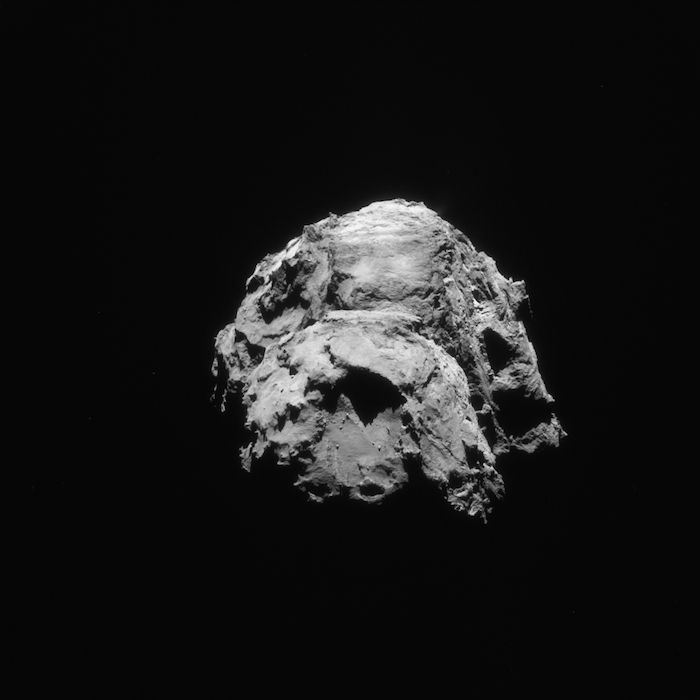
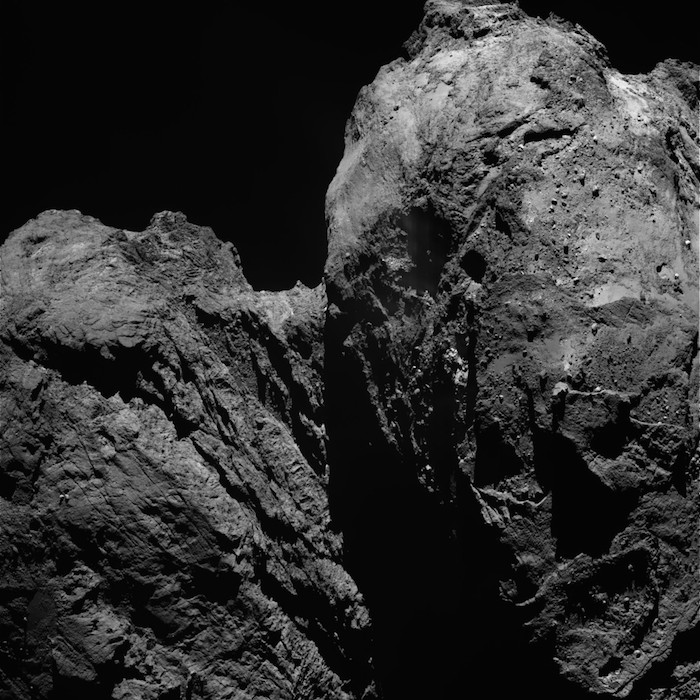
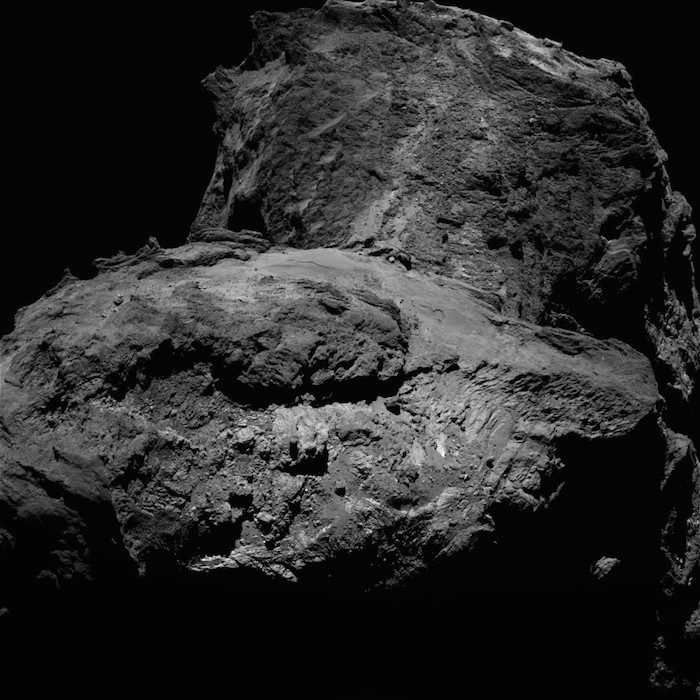
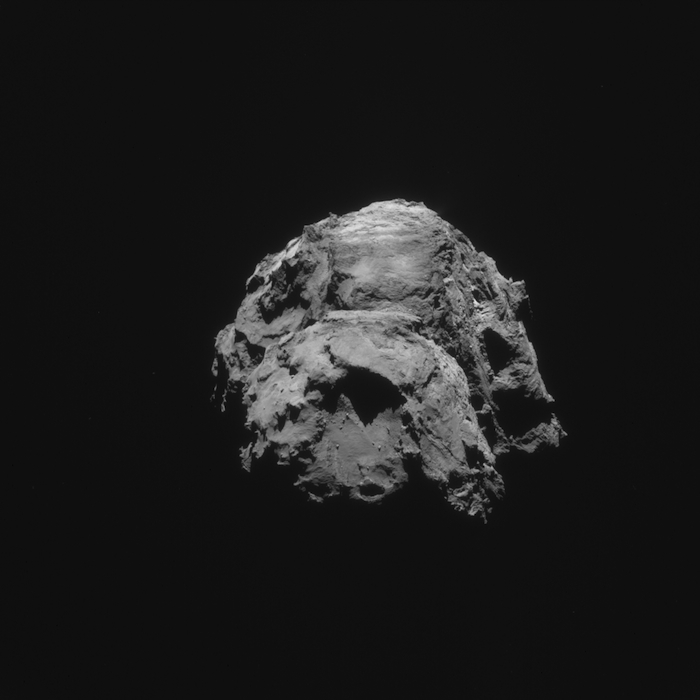
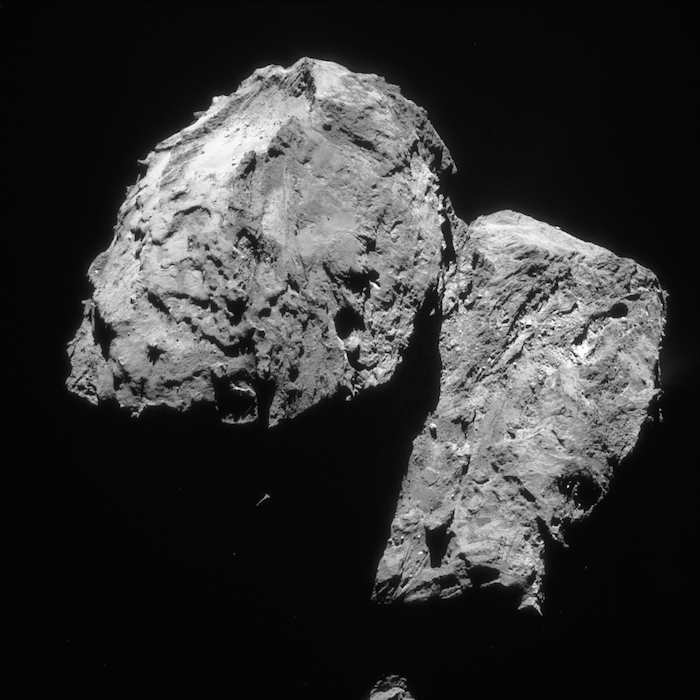

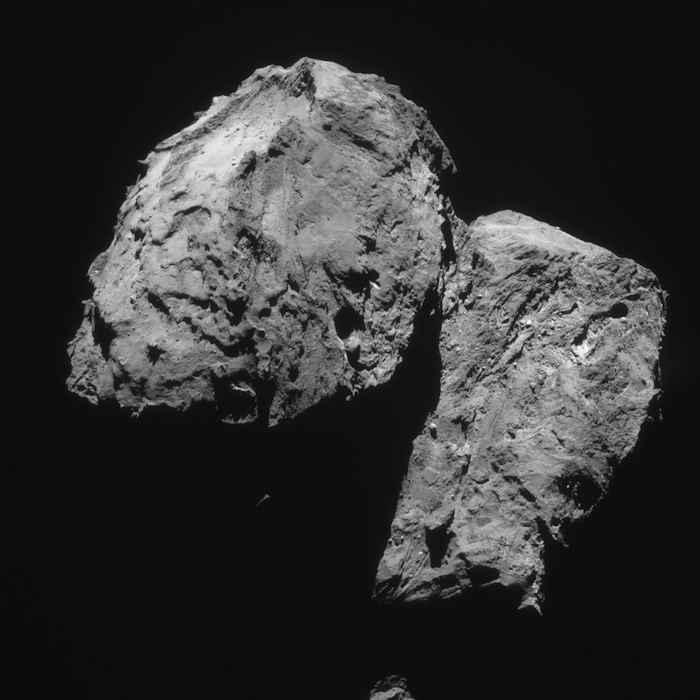
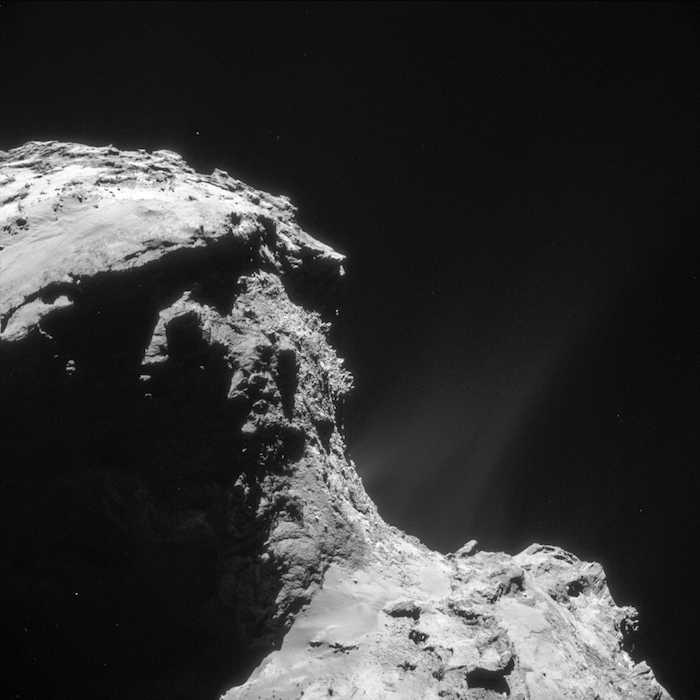
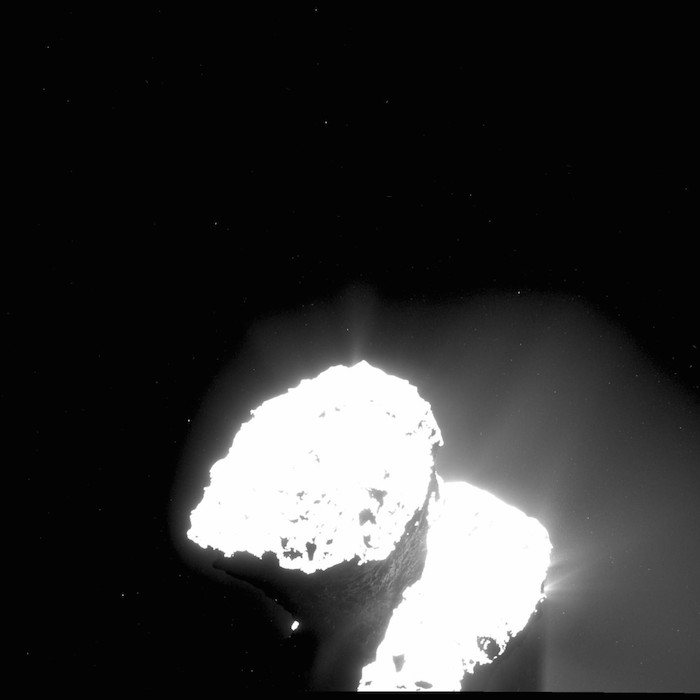
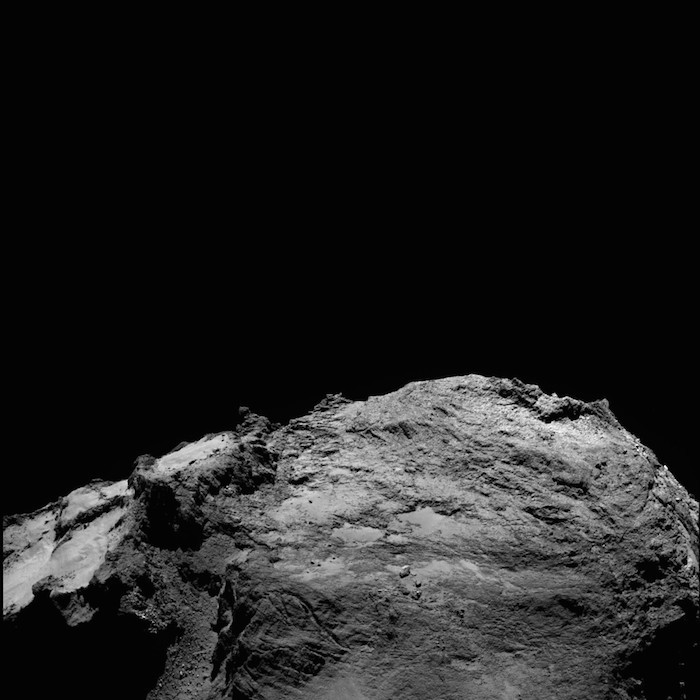
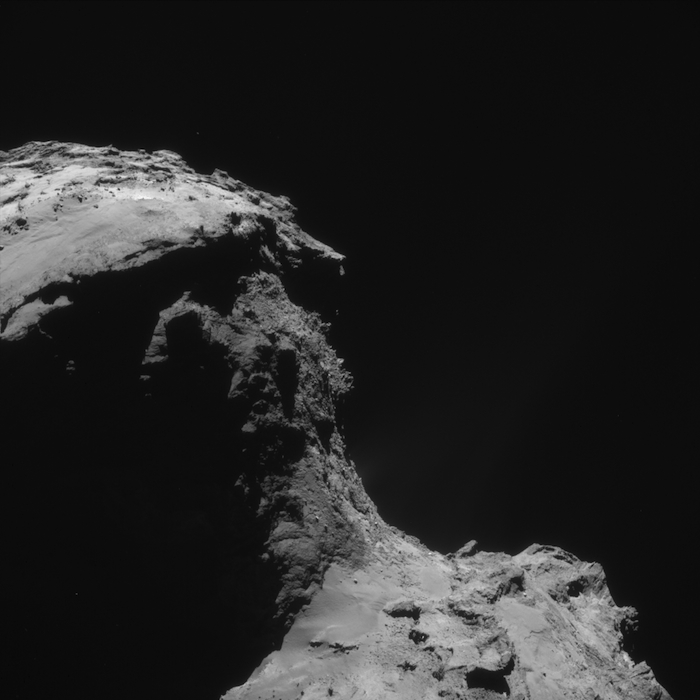
Auch wenn die Arbeit mit Philae Wünsche offen gelassen hat – beispielsweise die chemische Untersuchung einer Bodenprobe oder mehr Zeit für wissenschaftliche Messungen: „Solche hochaufgelösten und spektakulären Bilder wie von der ROLIS-Kamera gewonnene, die unterhalb des Landers sitzt, sowie von der Panoramakamera CIVA werden wir lange Zeit nicht mehr bekommen.“ Außerdem wurden mit einem Massenspektrometer organische Moleküle auf der Oberfläche gefunden und mit der Thermalsonde MUPUS sowie dem Seismometer SESAME physikalische Eigenschaften der Kometenoberfläche bestimmt. Der Kometenkern wurde von Sonde zu Lander mittels Radarstrahlen durchleuchtet, woraus Erkenntnisse über seine Struktur gewonnen werden konnten. Ein messbares Magnetfeld wies der Komet nicht auf. Viele Ergebnisse wurden inzwischen in wissenschaftlichen Journalen publiziert. „Die Auswertung der Daten wird jedoch noch über mehrere Jahre weitergehen“, betont DLR-Planetenforscher Dr. Ekkehard Kührt.
Wissen für zukünftige Missionen
Mit der Rosetta-Mission wurden gleich mehrere Premieren im All gefeiert: Noch nie begleitete eine Raumsonde einen Kometen auf seinem Weg um die Sonne, noch nie landete ein Gerät auf einer Kometenoberfläche, um dort Messungen durchzuführen. „Wenn man einen Vergleich mit anderen historischen Missionen sucht, wären dies vielleicht die Viking-Mission, die zum ersten Mal detaillierte Bilder vom Mars sendete, oder auch die Voyager-Sonden, die einen Blick auf die großen Planeten unseres Sonnensystems ermöglichten“, sagt Philae-Projektleiter Dr. Stephan Ulamec vom DLR. Die Landung mit Philae war zudem auch eine gute Lehrstunde: „Wir können zukünftige Missionen besser an die Bedingungen auf einem Kometen anpassen.“
Die letzten Fotos von Philae wird es sehr wahrscheinlich im Sommer 2016 geben, wenn die Rosetta-Sonde in nahen Vorbeiflügen auf den Lander blickt. „Wenn wir dann sehen, wie Philae positioniert ist, können wir manche Daten wie die Messungen des Radar-Experiments CONSERT noch besser interpretieren.“ In etwa sechs Jahren werden Philae und die Rosetta-Sonde, die im September 2016 zum Abschluss der Mission auf dem Kometen landen soll, zumindest wieder der Erde nahe sein – dann hat Komet Churyumov-Gerasimenko die Sonne ein weiteres Mal umrundet.
Die Mission
Rosetta ist eine Mission der ESA mit Beiträgen von ihren Mitgliedsstaaten und der NASA.
Die Mission wird im Europäischen Satellitenkontrollzentrum ESA / ESOC in Darmstadt gesteuert.
Rosettas Lander Philae wird von einem Konsortium unter der Leitung von DLR, MPS, CNES und ASI beigesteuert.
Quelle: ESA
-
Update: 5.03.2016
.
COMETWATCH – JANUARY PART 2
In this new NAVCAM view, taken 21 January, Comet 67P/Churyumov-Gerasimenko’s small lobe and its distinctive Hatmehit depression face directly towards Rosetta.
.

Lightly enhanced Rosetta NAVCAM image taken on 21 January 2016 from a distance of 78.9 km. The scale is 6.7m/pixel and the image measures 6.9 km across. Credits: ESA/Rosetta/NAVCAM – CC BY-SA IGO 3.0
-
The Bastet region on the small lobe faces directly up in this orientation, with Ma’at immediately to the left and Wosret to the right. In the background, on the large lobe, a swath of smoother terrain – defining Aker, with Khepry beyond – lies between the more rugged terrain of Babi (left) and Anhur (right).
Parts of these southern hemisphere regions (to the right in the NAVCAM image) were also seen in spectacularly detailed images captured by Rosetta’s OSIRIS narrow-angle camera this week. For example, the image below was taken on 27 January as part of an extensive surface mapping campaign. The complete sequence is aiming for a large coverage of the southern hemisphere to be used for 3D shape reconstruction and composition maps.
.

OSIRIS narrow-angle camera image captured on 27 January from a distance of 71.4 km. The image scale is 1.29 m/pixel.
Credits: ESA/Rosetta/MPS for OSIRIS Team MPS/UPD/LAM/IAA/SSO/INTA/UPM/DASP/IDA
-
The relatively flat Aker surface can be identified to the right in this image, with Khepry to the top and Anhur towards the foreground. Sobek (centre) marks the transition towards the small lobe (left) where distinctive fracture patterns are clearly seen in Wosret (far left).
As we learned in the original OSIRIS release yesterday, the image also features two regions not previously mentioned before: Neith and Bes. The details of the regions and the locations of the boundaries are still under study (and precisely why images like this are essential), but broadly speaking, Neith lies between Wosret and Sobek on the small lobe, and Bes lies to the right of Anhur and extends into the foreground of this particular image.
.

OSIRIS narrow-angle camera image captured on 23 January from a distance of 75.1 km. The image scale is 1.37 m/pixel. Credits: ESA/Rosetta/MPS for OSIRIS Team MPS/UPD/LAM/IAA/SSO/INTA/UPM/DASP/IDA
-
The OSIRIS team also released a striking new view focusing on the Khonsu region this week, at the boundary with Atum and Anubis (above). A variety of fracture-like features and layers are clearly visible. For example, zooming in close to the centre of the image reveals parallel sets of fracture lines that cross perpendicular to each other. On Earth and Mars this is often an indicator of ice that has contracted below the surface (see more examples and further discussion here).
Towards the right, long and near-parallel curvilinear features are evident and can be traced for some distance from the rugged terrain in the foreground to the smoother surface beyond. Understanding how features like these relate to the internal structure of the comet, and thus to the comet’s formation and evolution, is a hot topic for Rosetta mission scientists.
Meanwhile in the background of this image, much of the Anuket region on the comet’s small lobe is seen to the centre and left, with the transition into southern hemisphere regions towards the far right.
Catch up on recent OSIRIS images via the image of the day archive.
For help navigating the regions of the comet, see our comet viewer tool.
The original NAVCAM image from today’s CometWatch is provided below:
.

---
COMETWATCH FEBRUARY – PART 1
This month, Rosetta is approaching Comet 67P/Churyumov-Gerasimenko at 40 km or less, returning beautiful views of the nucleus and its surface features. In today's CometWatch image, we see the comet pictured by Rosetta's NAVCAM on 10 February 2016, when the spacecraft was 50.6 km from the comet nucleus.
.

Lightly enhanced NAVCAM image of Comet 67P/C-G taken on 10 February 2016, 50.6 km from the nucleus. The scale is 4.3 m/pixel and the image measures 4.4 km across. Credits: ESA/Rosetta/NAVCAM – CC BY-SA IGO 3.0
-
In this orientation, the small comet lobe is in the foreground, towards the top left of the frame, and the large lobe is farther away, in the lower-right part of the image. The view reveals most of the comet's southern hemisphere, which has been experience a short and intense summer since May 2015.
The illuminated portion of the large lobe is dominated by the southern region of Anhur, with hints of Sobek on the neck. Smooth portions of Aker and Khepry are also visible towards the upper edge.
A number of regions are depicted in this view of the small lobe: Maftet, Nut and Serqet towards the lower left, Bastet on the upper right edge of the lobe, but most notably the vast, round cavity of Hatmehit in the top left and the seemingly flat terrains of Wosret at the centre of the image.
The contrast between Hatmehit, covered in dust and boulders, and the rough features on the neighbouring Wosret region were also captured in another striking image, taken with the narrow-angle camera of Rosetta's OSIRIS imaging system on 13 February somewhat closer to the comet, at 45.8 km.
.

OSIRIS narrow-angle camera image taken on 13 February 2016, when Rosetta was 45.8 km from the comet. The scale is 0.82 m/pixel and the image measures 1.7 km across. Credit: ESA/Rosetta/MPS for OSIRIS Team MPS/UPD/LAM/IAA/SSO/INTA/UPM/DASP/IDA
-
The OSIRIS image provides a zoomed-in, detailed view onto this portion of the comet as seen in the NAVCAM image, although with a slightly different viewing angle, revealing a great deal of details about these two regions. A portion of Bastet is also visible in the OSIRIS image, including the brighter slab on the top edge of the lobe.
The original NAVCAM image is provided below.
.

---
COMETWATCH FEBRUARY – PART 2
This week’s CometWatch entry pictures Comet 67P/C-G as seen with Rosetta’s NAVCAM on 22 February, from a distance of 32.5 km to the centre of the comet.
.

Enhanced NAVCAM image of Comet 67P/C-G taken on 22 February 2016, 32.5 km from the nucleus. The scale is 2.8 m/pixel and the image measures 2.8 km across. Credits: ESA/Rosetta/NAVCAM – CC BY-SA IGO 3.0
At this close distance the comet nucleus overfills the camera’s field of view, but allows details of the surface to be seen at closer range than in previous weeks and months. This image focuses on the comet’s ‘neck’ region and the transition of smooth Hapi (centre) into Anuket to the left, and Seth on the large lobe to the right. Serqet is seen to the top left of the frame.
Furthermore, the composition of this image is such that traces of the comet’s activity are revealed, emanating from around the neck region and extending towards the top right of the frame.
This is nicely complemented by a wide-angle view taken by Rosetta’s OSIRIS wide-angle camera last week – and released today via the OSIRIS image of the day website – showing the current state of the comet’s activity all around the nucleus (below).
.

Comet 67P/C-G taken on 18 February by Rosetta’s OSIRIS wide-angle camera from a distance of about 35.6 km. The image scale is 3.45 m/pixel. Credits: ESA/Rosetta/MPS for OSIRIS Team MPS/UPD/LAM/IAA/SSO/INTA/UPM/DASP/IDA
-
Meanwhile the OSIRIS narrow-angle camera continues to capture ever-detailed views of the surface in high resolution. The image below was taken on 13 February and also released via the OSIRIS image of the day website this week.
.

Comet 67P/C-G taken on 13 February by Rosetta’s OSIRIS narrow-angle camera from a distance of about 46 km. The image scale is 0.84 m/pixel. Credits: ESA/Rosetta/MPS for OSIRIS Team MPS/UPD/LAM/IAA/SSO/INTA/UPM/DASP/IDA
The scene captures a detailed look at part of the Aker (foreground) and Khepry (background) regions, and extends into Babi towards the left of the image.
The original NAVCAM image for today's CometWatch entry is provided below:
.

Quelle: ESA
5600 Views
